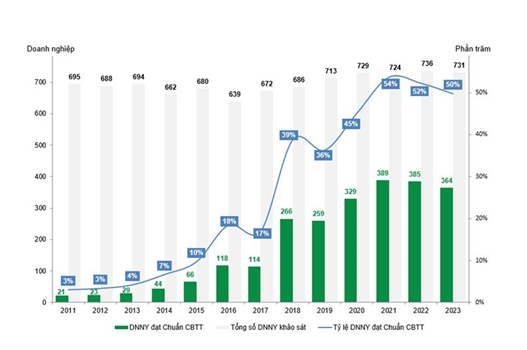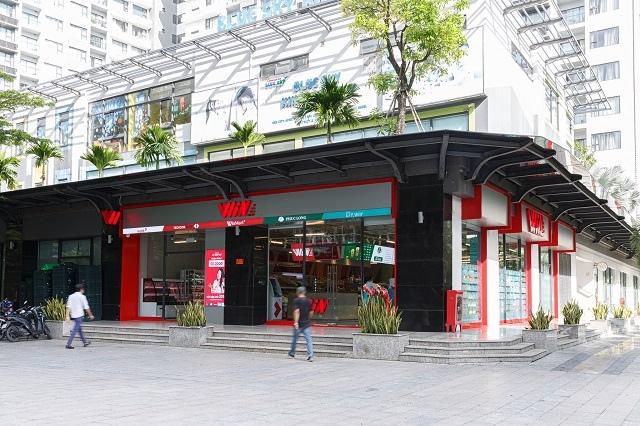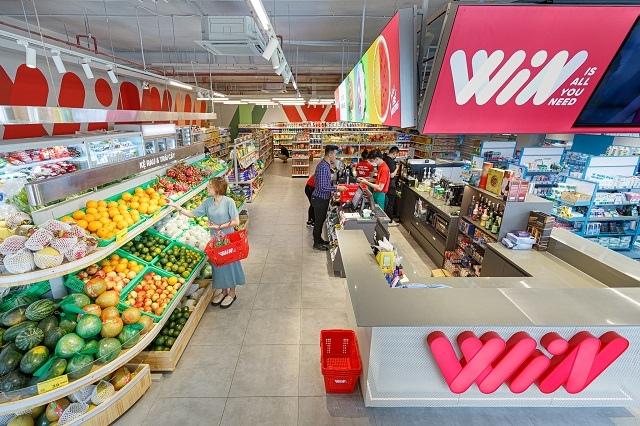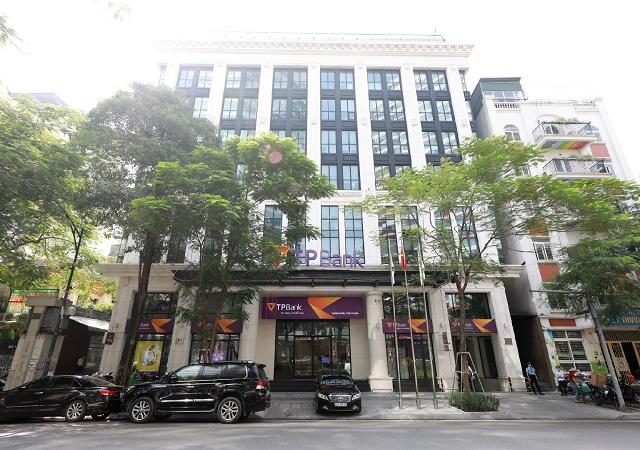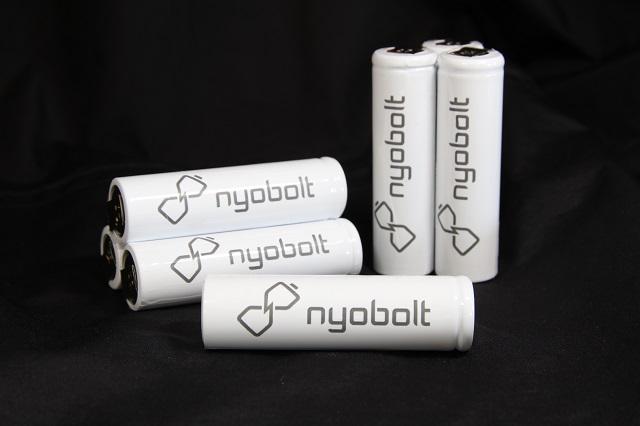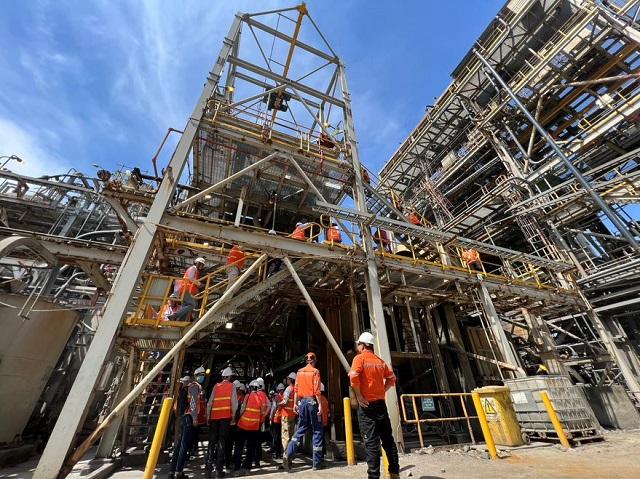Some sugar producers (SLS) see less positive outlook despite soaring prices
Some sugar producers (SLS) see less positive outlook despite soaring prices
After experiencing “sweet” results in the 2022-23 crop, many enterprises in the sugar industry set more cautious targets this fiscal year that started on July 1. However, the industry is still expected to have a promising year after sugar prices continuously set new highs.
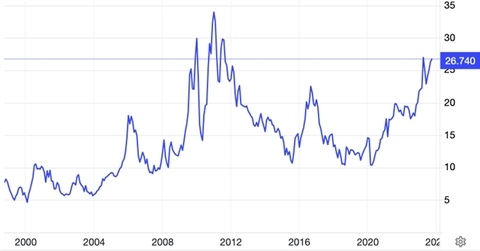
Sugar prices in the international market in the last 23 years. Source: tradingeconomics.com |
At the 2023 Annual General Meeting of Shareholders, Sơn La Sugar JSC passed the total net revenue plan of over VNĐ1 trillion (US$43 million), a decline of more than 39 per cent from last year’s performance. Its profit after tax is also set to fall nearly 74 per cent year-on-year to VNĐ137 billion, despite the record profit hit in 2022-23.
Cao Bằng Sugar JSC (Cabusa) has also announced a less optimistic picture of business results. In particular, its total revenue from producing sugar and profit after tax is set to fall 15 per cent and 49 per cent on-year over last year to VNĐ252 billion and VNĐ18 billion.
Similarly, Kon Tum Sugar JSC plans a net revenue of nearly VNĐ518 billion and profit after tax of nearly VNĐ28 billion, a decline of 5 per cent and 27 per cent, respectively.
A challenging market
Along with relatively safe business goals for the new year's crop, the leadership boards of these sugar producers made some cautious comments.
For instance, Sơn La Sugarcane predicts that the market may face difficulties in raw material prices and the impact of climate change that will reduce sugarcane output.
The company said that entering 2023, the sugar industry continues to face many challenges, especially climate change, and the El Nino phenomenon is quite serious, causing drought and heat in Sơn La and other Northwest provinces. This has a profound impact on sugarcane raw material areas, many of which have been recorded as dead or affected by drought.
As a result, there is a risk that productivity and output of the next crop will decrease sharply.
Moreover, prices of agricultural materials remain high, reducing the incomes of sugarcane growers; its raw material areas are facing fiercer competition from other peers.
Cao Bằng Sugar also believes that, besides favourable conditions, risks such as the Government's decision to increase the sugar import quota and the lack of strict control over illicit sugar trade exist. These factors can create opportunities for smuggled sugar to dominate the domestic market.
Additionally, the company's source of raw materials is affected by competitive purchasing, leading to a shortage of raw materials, and a reduced scale of production will impact business efficiency.
On the other hand, Kon Tum Sugar's Board of Directors said that the global economy still faces many uncertainties. Illicit activities and trade fraud in the sugar industry, including export production and temporary import for re-export, have not been thoroughly controlled.
Climate change also significantly affects the productivity and quality of many sugarcane cultivation areas, while prices of agricultural materials such as fertilisers and plant protection chemicals, as well as industrial chemicals, have risen sharply.
Bullish momentum in long-term
However, new highs in sugar prices are seen as an advantage of the industry this year.
Since the end of 2022, international sugar prices have continuously risen due to unfavourable weather conditions, causing supplies in major markets such as Brazil, India, and China to diminish. Sugar is traded at 26.74 cents/pound, its peak in 12 years.
Meanwhile, India has only permitted the export of 6 million tonnes of sugar in the 2022-23 crop year, a significant decrease from the record level of nearly 12 million tonnes in the previous crop year, to ensure domestic supply.
The Indian government is also expected to officially ban factories from exporting sugar in the next crop year, starting from October. This move to suspend India's exports occurs for the first time in seven years as a lack of rain reduces sugarcane productivity.
Many sugar organisations predict that the sugar supply will continue to tighten in 2023-24 due to dry weather affecting sugarcane output and rising crude prices. Part of the sugarcane output is converted into raw materials for ethanol production.
According to the Vietnam Sugarcane and Sugar Association (VSSA), domestic sugar output is expected to reach 87,000 tonnes in the current crop year, a gain of 16.6 per cent year-on-year.
Domestic sugar prices are also projected to remain high and align with global sugar prices in 2023 because imported sugar makes up 2/3 of the country's sugar supply.
In a recent report, SSI Research anticipates that the Ministry of Industry and Trade will increase the maximum import volume of sugar according to the tariff quota for 2023 to supplement the domestic sugar supply. This will benefit domestic refined sugar mills that import raw sugar. SSI also expects that rising domestic sugar prices will encourage farmers to return to sugarcane cultivation.
Anti-subsidy and anti-dumping policies applied to Thai sugar to protect domestic production enterprises are factors that contribute to long-term improvements in domestic sugar output and prices.
On the stock market, sugar stocks have not performed positively recently due to strong corrections of the market's benchmarks. However, the level of fluctuation wasn't as significant as those in the securities, real estate, and banking industries, Lê Xuân, a HCM-based independent trader, told Việt Nam News.
"However, in the medium and long term, I believe the sugar industry also has advantages such as the persistent El Nino phenomenon, causing sugar prices to rise recently, export suspensions from major suppliers like India, and reduced production output from Thailand," Xuân said.
"In addition, the increase in the exchange rate for the US dollar against the đồng benefits sugar enterprises with export activities that account for a significant proportion of their revenue."
However, she noted the importance of monitoring the sugar smuggling situation and the trade defence measures of countries when analysing the industry.
Last week, the market declined by more than 2 per cent, but SLS shares of Sơn La Sugar rose 1.4 per cent, and KTS of Kon Tum Sugar increased by 1.1 per cent. In contrast, CBS of Cao Bằng Sugar dropped by 3.1 per cent.








